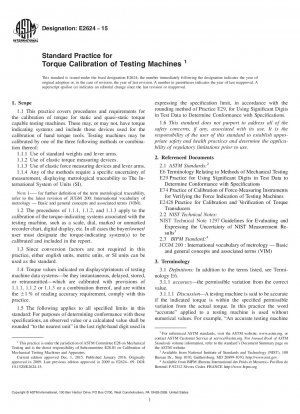ASTM E2624-15
Standard Practice for Torque Calibration of Testing Machines
- Standard No.
- ASTM E2624-15
- Release Date
- 2015
- Published By
- American Society for Testing and Materials (ASTM)
- Status
- Replace By
- ASTM E2624-17
- Latest
- ASTM E2624-17
- Scope
4.1 Testing machines that apply and indicate torque are used in many industries, in many ways. They may be used in a research laboratory to measure material properties, and in a production line to qualify a product for shipment. No matter what the end use of the machine may be, it is necessary for users to know the amount of torque that is applied, and that the accuracy of the torque value is traceable to the SI. This standard provides a procedure to verify these machines and devices, in order that the indicated torque values may be traceable. A key element to having metrological traceability is that the devices used in the calibration produce known torque characteristics, and have been calibrated in accordance with Practice E2428.
4.2 This standard may be used by those using, those manufacturing, and those providing calibration service for torque capable testing machines or devices and related instrumentation.
1.1 This practice covers procedures and requirements for the calibration of torque for static and quasi-static torque capable testing machines. These may, or may not, have torque indicating systems and include those devices used for the calibration of hand torque tools. Testing machines may be calibrated by one of the three following methods or combination thereof:
1.1.1 Use of standard weights and lever arms.
1.1.2 Use of elastic torque measuring devices.
1.1.3 Use of elastic force measuring devices and lever arms.
1.1.4 Any of the methods require a specific uncertainty of measurement, displaying metrological traceability to The International System of Units (SI).
Note 1: – for further definition of the term metrological traceability, refer to the latest revision of JCGM 200: International vocabulary of metrology — Basic and general concepts and associated terms (VIM).
1.2 The procedures of 1.1.1, 1.1.2, and 1.1.3 apply to the calibration of the torque-indicating systems associated with the testing machine, such as a scale, dial, marked or unmarked recorder chart, digital display, etc. In all cases the buyer/owner/user must designate the torque-indicating system(s) to be calibrated and included in the report.
1.3 Since conversion factors are not required in this practice, either english units, metric units, or SI units can be used as the standard.
1.4 Torque values indicated on displays/printouts of testing machine data systems—be they instantaneous, delayed, stored, or retransmitted—which are calibrated with provisions of 1.1.1, 1.1.2 or 1.1.3 or a combination thereof, and ar......
ASTM E2624-15 Referenced Document
- ASTM E2428 Standard Practice for Calibration and Verification of Elastic Torque Measurement Standards
- ASTM E29 Standard Practice for Using Significant Digits in Test Data to Determine Conformance with Specifications
- ASTM E6 Standard Terminology Relating to Methods of Mechanical Testing
- ASTM E74 Standard Practices for Calibration and Verification for Force-Measuring Instruments
ASTM E2624-15 history
- 2017 ASTM E2624-17 Standard Practice for Torque Calibration of Testing Machines
- 2015 ASTM E2624-15 Standard Practice for Torque Calibration of Testing Machines
- 2009 ASTM E2624-09 Standard Practice for Torque Calibration of Testing Machines and Devices

Copyright ©2024 All Rights Reserved